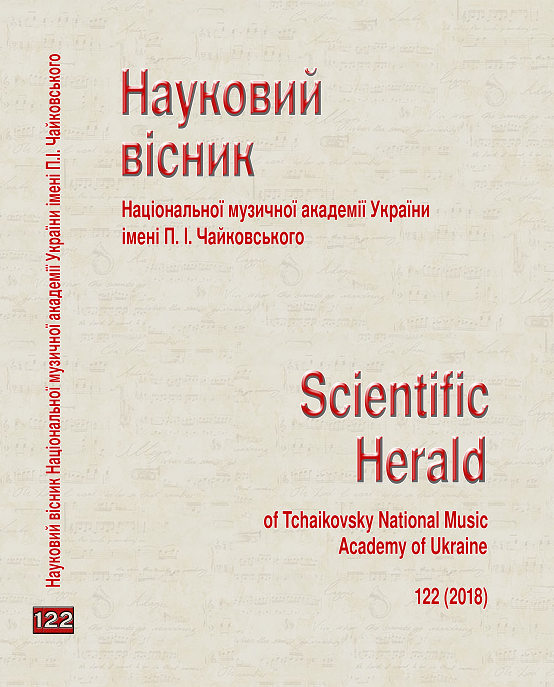The interaction of compositional and performing means of expressiveness in the Second Sonata-Ballade by Boris Lyatoshinsky
DOI:
https://doi.org/10.31318/2522-4190.2018.122.141857Keywords:
musical means of expressiveness, compositional means of expressiveness, performing means of expressiveness, interpretation, B. Lyatoshinsky’s piano oeuvreAbstract
Relevance of the study. Despite the division of the spheres of compositional and performing musical creativity the traditional generally accepted distinction between compositional and performing means of expressiveness is recognized by many researchers as ambiguous and conditional. The unprecedented actualization of the "secondary" performing means of expressiveness in the musical art of the twentieth century stipulates the urgency of applying this aspect of research to the study of the early piano pieces by the leading Ukrainian composer of the twentieth century Boris Lyatoshinsky. Main objective of the study is to highlight the interaction of compositional and performing means of expressiveness in the Second Sonata-Ballade by B. Lyatoshinsky.
Methodology. A holistic musical-theoretical analysis is applied to determine the figurative content of a work, to reveal the features of form-building and the use of compositional means of expressiveness (the intonational structure of the basic elements of the form, the tonal-harmonic plan, the methods of development of the thematic material). Complex interpretation analysis is applied to study how performing means of expressiveness (tempo-rhythm, agogics, pedalization, dynamics) are used in their interaction with composer means of expressiveness.
Results and conclusions. In this work, the composer counts on the significant co-creative role of the interpreter. So, the definition of the tempo plan of the work is essential for the perception of the form, which ambivalence is evident already from the title of the work. A significant degree of metrorhythmic freedom is expected with accurate observance of rhythmic figures of a nervous, impulsive nature. It is necessary to use special dynamic and pedal techniques to identify impressionistic features of the B. Lyatoshinsky’s piano texture.
Practical significance. The thourough understanding of the dialectics of interaction between compositional and performing means of expressiveness is necessary in order to achieve an adequate and convincing interpretation of this outstanding work of Ukrainian piano music.
Downloads
References
Belza, I. (Ed.) (1972), Piano works by Boris Lyatoshinsky : B. Lyatoshinsky. Sochineniya dla fortepiano [B. Lyatoshinsky. Piano works], Muzyka, Moscow, 132 p. [in Russian].
Davydov, N. (2013), “Aspects of performer’s thinking”, Tavriyski studiyi. Mysteztvoznavstvo [Taurica Studies. Theory of Art], vol. 3, [in Russian], available at: http://nbuv.gov.ua/UJRN/tsm_2013_3_5 (accessed 01 feb 2018).
Klin, V. (1987), “Piano oeuvre and artistic style of B. N. Lyatoshinski”, Boris Nikolayevich Lyatoshinsky, Muzychna Ukrayina, Kyiv, pp. 42-62 [in Russian].
Korykhalova, N. (1979), Interpretation of music: theoretical problems of performance and critical analysis of their research in the modern bourgeoise aesthetics, Muzyka, Leningrad, 208 p. [in Russian].
Lyatoshinsky, B. (2002), Epistolary heritage, vol. 1, Kyiv, 768 p. [in Russian, Ukrainian].
Malinkovskaya, A. (2005), Class of the main musical instrument: the art of piano intonation, VLADOS, Moscow, 381 p. [in Russian].
Martsenkivska, O. (2014), “General tendencies of romanticism in music and their manifestation in the piano oeuvre by B. Lyatoshinsky”, Kyyivske muzykoznavstvo [Kyiv musicology], vol. 48, pp. 132-148 [in Ukrainian].
Moskalenko, V. (2012), Lectures on musical interpretation, Kyiv, 272 p. [in Russian].
Pidsukha, O. (1995), “On the problem of the B. Lyatoshinsky’s stylistic searches in 1920s in context of the contemporary european stylistic tendencies”, Muzychny svit Borysa Lyatoshynskoho [Boris Lyatoshinsky’s music world], Tsentrmuzinform, Kyiv, pp. 26-29 [in Ukrainian].
Pyaskovsky, I. (1991), “Renovation of the romantic and postromantic traditions in the harmonic thinking of B. Lyatoshinsky”, Ukrayinske muzykoznavstvo [Ukrainian musicology], vol. 26, pp. 74-93 [in Ukrainian].
Samokhvalov, V. (1970), Features of the B. Lyatoshinsky’s musical thinking, Muzychna Ukrayina, Kyiv, 280 p. [in Russian].
Sokol, A. (2007), Performer’s directions, image of the world and music style, Moryak, Odessa, 276 p. [in Russian].
Stepanyuk, O. (2013), “Steshenko-Kuftina Valentyna Kostyantynivna”, Naukovy visnyk NMAU im. P.I.Chaykovskoho [Scientific Messenger of the NMAU in the name of P.Tchaikovsky], vol. 101, pp. 468-469 [in Ukrainian].
Steshenko-Kuftina, V. (2013), “From the diary. Letters by B. N. Lyatoshinsky to V. K. Steshenko-Kuftina”, Naukovy visnyk NMAU im. P.I.Chaykovskoho [Scientific Messenger of the NMAU in the name of P.Tchaikovsky], vol. 101, pp. 344-367 [in Russian].
Tarasova, O. “Articulation complex in music: theoretical aspect”, Tradytsiyi ta novatsiyi u vyshchiy arkhitekturno-khudozhniy osviti [Traditions and innovations in higher education in architecture and arts], vol. 1, 2, 3, pp. 124-127 [in Russian].
Kharchenko, Ye. (2011), Intertextuality in the Ukrainian music of the 20th century: intonation, genre, style, PhD diss. (music art), Institute of Art Studies, Folklore Studies and Ethnology named after M.T. Rylsky, 353 p. [in Ukrainian].
Tsarevych, I. (1972), “Instrumental chamber ensembles by B. Lyatoshinsky created in 1920s”, Ukrayinske muzykoznavstvo [Ukrainian musicology], vol. 7, pp. 103-118 [in Ukrainian].
Downloads
Published
How to Cite
Issue
Section
License
Our journal abides by the CREATIVE COMMONS copyright rights and permissions for open access journals.
Authors, who are published in this journal, agree to the following conditions:
The authors reserve the right to authorship of the work and pass the first publication right of this work to the journal under the terms of a Creative Commons Attribution License, which allows others to freely distribute the published research with the obligatory reference to the authors of the original work and the first publication of the work in this journal.
The authors have the right to conclude separate supplement agreements that relate to non-exclusive work distribution in the form in which it has been published by the journal (for example, to upload the work to the online storage of the journal or publish it as part of a monograph), provided that the reference to the first publication of the work in this journal is included.




